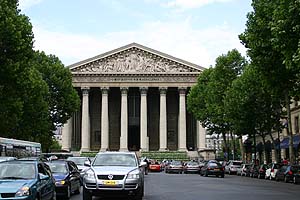L'eglise de la Madeleine

L'eglise de la Madeleine, or L'eglise Sainte-Marie-Madeleine (or simply "La Madeleine"), is a church in the 8th arrondissement of Paris that was designed as a temple to the glory of Napoleon's army.
Three false starts were made on building a church on this site. The first design, commissioned in 1757 with construction begun in 1764, was by Pierre Contant d'Ivry, and was based on Mansart's Late Baroque church of Les Invalides, with a dome surmounting a Latin cross. In 1777 d'Ivry died and he was replaced by Guillaume-Martin Couture, who decided to start anew, razing the incomplete construction and basing his new design on the Pantheon. At the start of the Revolution, only the foundations had been finished and work was discontinued, while debate simmered as to what purpose the building might serve in Revolutionary France: a library, a ballroom (http://wiktionary.org/wiki/Ballroom), and a marketplace were all suggested.

In 1806 Napoleon made his decision, commissioning Pierre-Alexandre Barthelemy Vignon (1763-1828) to build a Temple de la Gloire de la Grande Armee (Temple to the Glory of the Great Army), with Vignon basing his design on an antique temple. The then-existing foundations were razed and work begun anew. With completion of the Arc de Triomphe in 1808, the original commemorative role for the temple was blunted. After the fall of Napoleon, with the Catholic reaction during the Restoration, King Louis XVIII determined that the structure would be used as a church. Vignon died in 1828 before completing the project and was replaced by Jacques-Marie Huve. In 1837 it was briefly suggested that the building might best be utilized as a train station, but the building was finally consecrated as a church in 1842.

Interior of the Eglise de la Madeleine, ParisThe Madeleine is built in the Neo-Classical style and was inspired by the Maison Carree at Nimes, the best-preserved of all Roman temples. Its 52 Corinthian columns, each 20 metres high, are carried around the entire exterior of the building. The pediment is adorned by a sculpture of the Last Judgement by Lemaire, and the church's bronze doors bear reliefs representing the Ten Commandments.
Inside, the church has a single nave with three domes, lavishly gilded in a decor inspired by Renaissance artists. At the rear of the church, above the high altar, stands a statue by Charles Marochetti depicting St Mary Magdalene being carried up to heaven by two angels. The half-dome above the altar is covered with a fresco by Jules-Claude Ziegler, entitled The History of Christianity, showing the key figures in the Christian religion with - perhaps inevitably - Napoleon occupying centre stage.
The Madeleine is affiliated with a Benedictine abbey, and masses and the most fashionable weddings in Paris are still celebrated here.
The church has a celebrated pipe organ, built by Aristide Cavaille-Coll (1811-1899), which is widely regarded as one of the best in Paris. The composers Camille Saint-Saens and Gabriel Faure were both organists at the Madeleine, and the funerals of Frederic Chopin and Faure were held there.